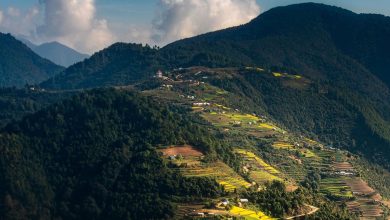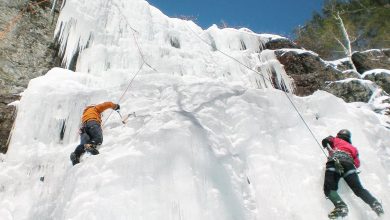Nepal’s Kumari Devi – The Only Living Child Goddess In The World
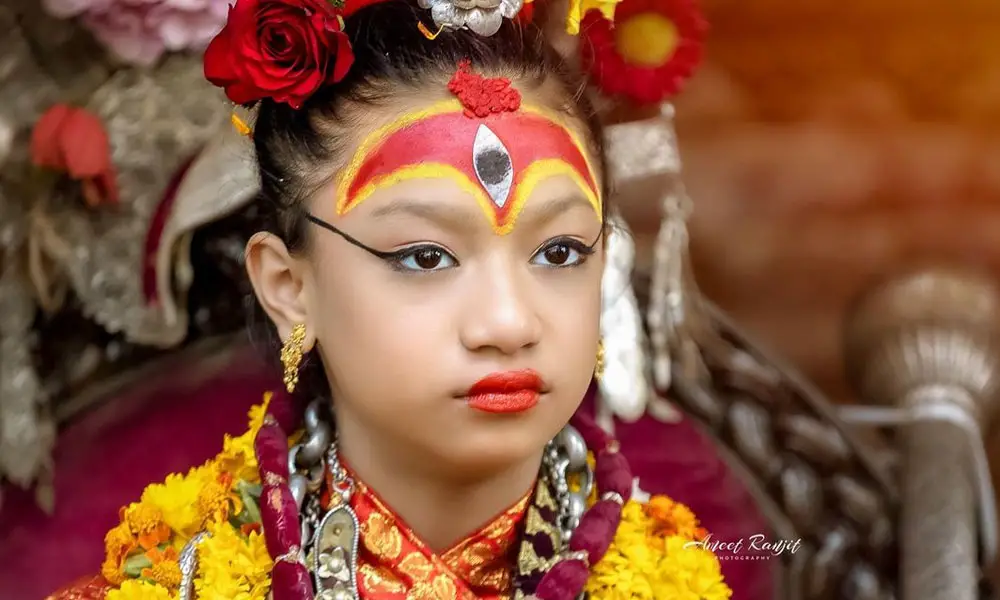
Nepal is a culturally rich country – more than 125 ethnic groups reside within it, with distinctive cultures and traditions. Newar community, residing in Kathmandu Valley and several other cities of Nepal, is one ethnic group that is very rich in traditional culture. The Newari people celebrate several events, festivals, jatras parwas, and feasts, reflecting their significant culture and traditions. Among them, one of the most popular events is Kumari Puja.
During Kumari Puja, local people and devotees visit the Kumari Temple just next to Kathmandu Dubar Square to seek her blessings. They offer several offerings like flowers, fruits, and incense for the worship event and perform prayers and rituals in her presence. During the time of Indra Jatra, these events were initiated.
Kumari Puja is a symbol of the divine feminine power and is an important cultural and religious tradition in Nepal and parts of India. It demonstrates the belief in the living presence of the goddess among her devotees and is an integral part of many Hindu festivals and celebrations.
Kumari Puja is a globally recognized event where young girls (from a Bajracharya/Shakya Family) are ritually selected as the Living Goddess and worshiped. There are also several other stories regarding Kumari Pratha and Kumari Puja. So, what is the story about the Living Goddess of Nepal and its cultural importance? Let’s find out here in this blog. Also, you might find it amusing to read how Kumari Puja started in Nepal.
Kumari Puja | How Did It Start in Nepal?
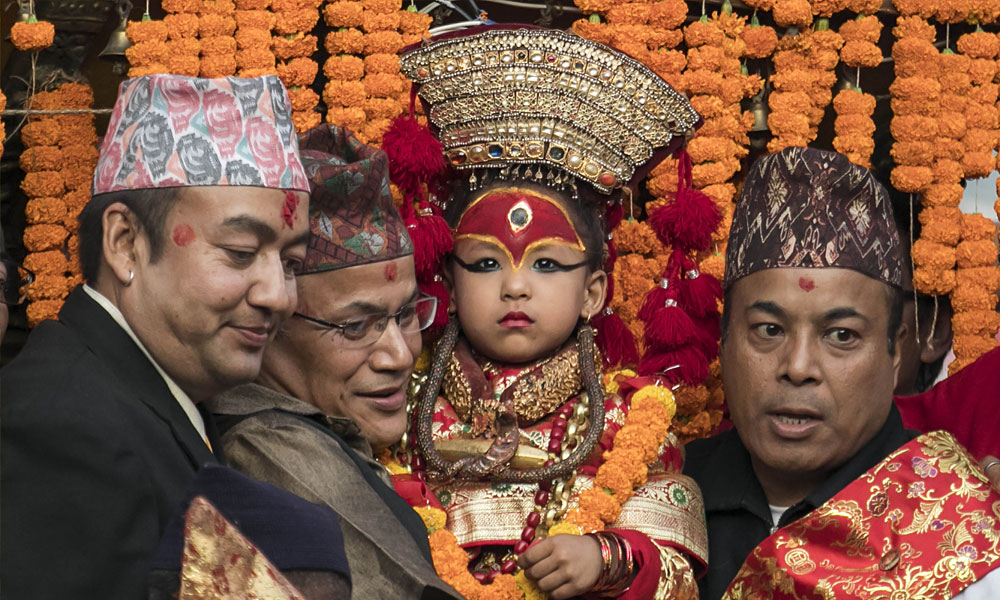
Kumari Puja is one of the most famous celebrations in Kathmandu, the Capital City of Nepal. With the wide celebration of Kumari Puja in the Kathmandu Valley, the question surely arises stating when did it start in Nepal. Well, we are here to uncover the facts regarding Kumari Puja carried out in the Newari community of Kathmandu Valley. Let’s explore the facts in detail:
The Nepalese history cites that the Kumari Tradition in Kathmandu started in the 877th year in the Newari Calendar. If you look at the Western calendar, it is around 1757 AD. So, it is safe to say that the tradition of Kumari Puja started in the eighteenth century.
Concerning this unique tradition of the Newari community, several tales and stories swirl around, creating curiosity among people. One of the most popular tales is about King Jaya Prakash Malla, an ancient Malla King of Nepal, defeated by King Prithvi Narayan Shah of Gorkha in 1825 B.S.
As per the history, King Jaya Prakash Malla used to play dice games with the Goddess of Taleju in his chamber. Taleju was the clan deity of the Malla Kings, and the story was neither to be told by him nor to be discovered by anyone. However, things never went as expected, as Malla’s Queen found him playing dice with Goddess Taleju one day.
As the Queen discovered them playing dice together, which was not to be meant, Goddess Taleju disappeared. But before leaving the chamber, Goddess Taleju told Jaya Prakash Malla that she would re-incarnate herself as a little girl of the Newari (Shakya) community of Ratnawali. Upon getting such messages, the King went on a raid mission to discover the young girl possessed by Taleju’s spirit. After that, the tradition of Kumari Puja started in Kathmandu.
Some historians deny the facts and tales about Jaya Prakash Malla and cite that it was actually Trilokya Malla, not Jaya Prakash Malla. The tale is also very different from the previous one. It was a fact that King Trilokya played dice with Goddess Taleju, but once corrupted with evil desires, he approached the deity with sexual intentions. As the goddess discovered his intentions, she immediately disappeared, after which the King regretted his actions. Also, he pleaded not to repeat his embarrassing actions. Looking at the condition of King Trilokya, Goddess Taleju mentioned that she would appear in the body of a Kumari, a young girl from the Shakya Family. It is another story that cites how the Kumari Tradition started in Nepal.
To be fair, there are several tales and stories regarding the Kumari culture and tradition. However, there are no actual findings of when it started and the reasons behind it. Some even state that the Kumari Tradition was a part of the now-extinct Newari religion. However, after the valley was unified to the Gorkha Kingdom after Prithvi Narayan Shah defeated the Malla Kings of three cities, it also mixed up with other beliefs.
Kumari Selection Process | How Is It Done?
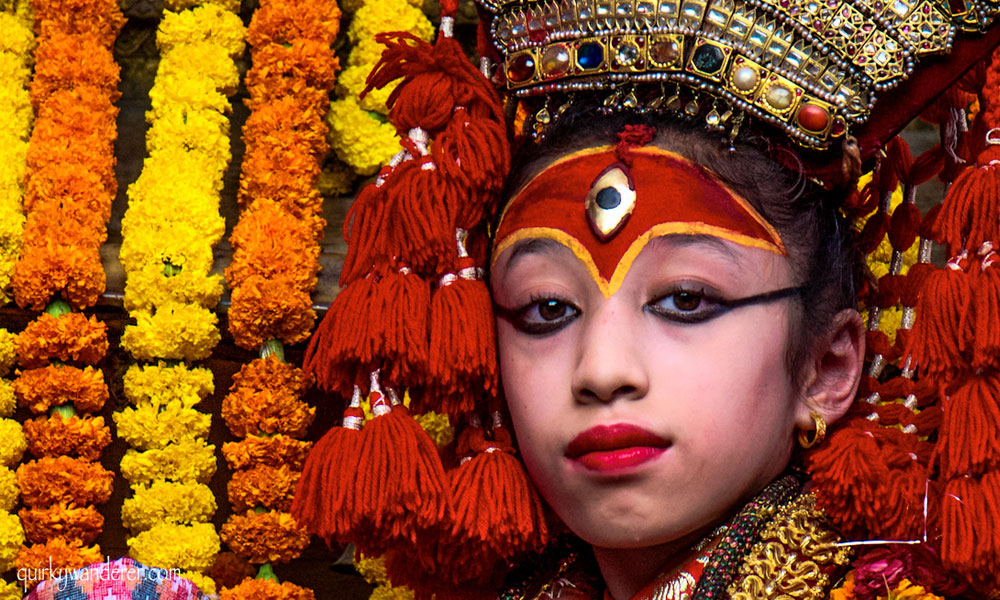
The selection process of Kumari, a living goddess in Nepal, follows very strict criteria. It’s not easy to select a Kumari Goddess; it involves a rigorous process examined by senior Buddhist priests. Similarly, the high command of the selection process is handled by the Chief Royal Priest of Taleju Temple and the Royal Astrologer.
If you go through the history of Kumaris in Nepal, there are several Kumaris, the most famous being from Kathmandu Valley. Kumaris from the Kathmandu Valley are known as the Royal Kumari. Similarly, Kumari Traditions are also practiced in Patan and Bhaktapur districts. All the Kumaris must come from Newari Buddhist Families, especially from the Shakya community.
To be a Kumari, the girl must belong to the Shakya Caste of silver and goldsmiths. Similarly, her three generations of clan influence in the process. It means that three of her past generations must be married within the same caste, or she will not be considered in the selection process. Similarly, there are several health criteria that a girl must possess. She must be very healthy and fit with no serious illness or bleeding. Moreover, various astrological tests are also done for the process, which include that a girl must possess 32 attributes (Battish Lakshin), and her horoscope must be compared to the King’s for compatibility. Some of the attributes include the following characteristics:
- Eyelashes like a cow
- Thighs like of deers
- Neck like a cohen shell
- Chest like of lion
- Body like a Banyan tree
- A voice like a duck’s melodious
- Same horoscope as the kings
- The vision of calmness and fearlessness
- Black and straight hair and many more
The selection process does not end here; there are still so many tests a girl should pass before being a Kumari. The girl must not have any physical endangerment, with no physical blemishes. The head priest’s wife operates these tests. Similarly, the girl must have a strong birth star for the selection. This process happens on the 8th day of the main festival, Dashain, also known as Kalratri.
Last but not least, the final test comes into action. It includes a girl being taken into a room where 108 buffaloes and goats are sacrificed to the Hindu Goddess, Kali. During this process, the scenario is vibrant in culture. Masked men dance around the surroundings, and the girl must display fearlessness during this time. After that, the girl is provided with traditional ornaments. The most tricky part is that the girl must choose the same ornaments as the previous Kumaris. After passing these tests, she is appointed as the Living Goddess Kumari.
After the girl passes all these tests, she must go through several ancient traditional rituals the Royal Priests operate. After it is completed, it is believed that the spirit of Taleju inhabits her body. After the ceremony ends, she is taken to the Kumari House – an ancient house built next to the palace. The courtyard of the Kumari house is known as Kumari Chowk.
The most important thing to know about Kumaris is that most of them are chosen as a toddler. The girl must be a virgin. It is believed that girls who have experienced their first menstrual cycle cannot be considered a contender for Kumari. People believe they can no longer be considered as the reincarnation of the Goddess Taleju.
The youngest Kumari was 3 years old, while the oldest Kumari was 73 years old, Dhana Kumari Bajracharya.
Did You Know Kumaris Have Their Own Ceremonial Garment?
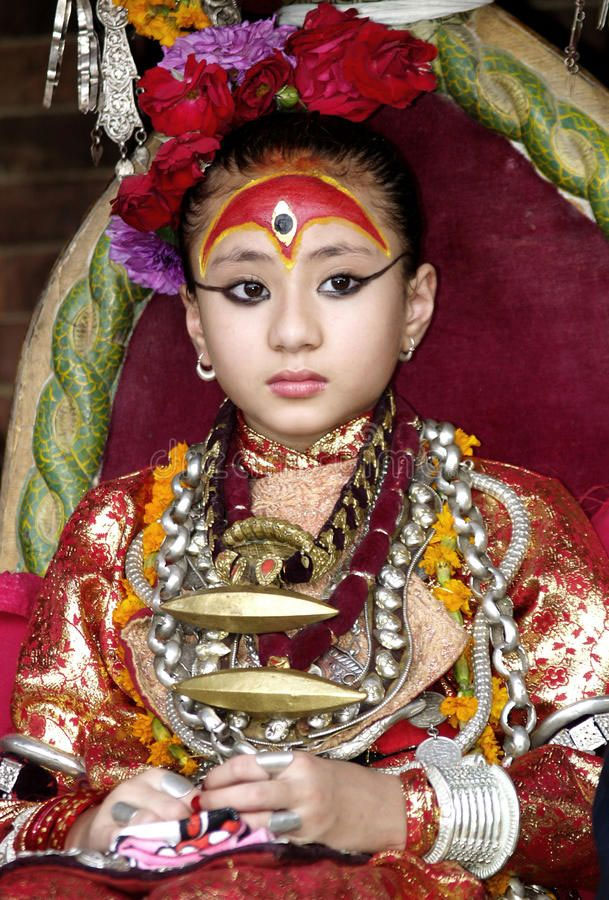
It is an amazing fact that Kumari is not only considered the reincarnation of the Taleju Goddess but also the symbol of beauty in the Newari community. Commonly, the common beautiful girls are compared to the beauty of the Kumari. People say that the Kumari fascinates with its beauty and divine power, and she is very distinctive. She can be identified from a distance because of her appearance and makeup.
She wears a distinctive bright red Jama (cloak) down to her feet, a red blouse called Bhoto, and a precious headpiece made of gold and other metals and gemstones.
Kumaris always wears red clothing and is prohibited from wearing garments of any other color. Even at home, she is not allowed to do so. After her timeframe ends as Kumari, her ceremonial attire is passed down to other new Kumaris, adding to its significance.
As we talked, Kumaris also wear precious ornaments, including gold, silver, and other metals. These ornaments date back to the 13th century, at the ending time of the Malla Regime. These ornaments also have deep spiritual meaning. Kumari dons diamond and gold coin earrings and two necklaces. One of the necklaces is ‘Bashuki Naga,’ the God of wealth. This ornament is designed like a snake to protect Kumari from evil. Similarly, the next ornament is Ta-yo, representing the eight mother goddesses. It signifies the prosperity and protection of the Kumaris.
If you look at the face of Kumari, they have a very unique form of makeup. Kumari’s forehead is adorned with indoor (Vermilion) powder, covering her entire forehead. Similarly, the yellow pigment from turmeric and sandalwood is also painted on her forehead. In the center of her forehead is a painting of ‘Fire-Eye’ (Agni-Chakshu), representing cosmic energy or the destroyer of evil. The fire eye is crafted from precious metals like gold or silver.
Kumaris are decorated in the highest form, and their attire and makeup are top-notch. This also includes their hairstyles. They have topknot-adorned hair with fragrant flowers and red ribbon. She also has a distinctive eye makeup that sets her apart from others, and it has been a trademark look of Kumaris in Newari culture. Like her forehead, her feet are also painted with red pigments (Ala), a traditional Newar pedicure. Kumari does not wear shoes but may have red stockings on her feet.
Importance of Kumari Puja and Culture

As Nepal is a multi-cultural and multi-religious country, there have been several celebrations, festivals, and cultures in numerous amounts. One is Kumari Puja – which carries great significance in the Newari people of the Kathmandu valley. What is the cultural importance of Kumari Pratha? Let’s explore this in detail here:
The Kumari culture is one of the world’s most fascinating and unique traditions. This tradition is only practiced in Nepal, where a young pre-pubescent girl is worshipped as the Goddess Taleju. This shows how deeply the Nepalese community is religious and follows the ancient tradition. Nepal being a religious country, this tradition stems Nepal is a religious country, and this tradition stems from a time when Kings ruled the land.
As per the popular tale, Jaya Prakash Malla of the Malla Dynasty introduced the Kumari culture to protect his Kingdom. But sarcastically, he was Kathmandu’s last King of the Malla Dynasty. Kumari, believed to embody Goddess Taleju, is worshipped as a symbol of power and prosperity. Also, people believe that Kumaris have supernatural abilities, including healing illnesses and granting wishes. Most importantly, women with blood-related ailments consider themselves healed by Kumari, the Living Goddess of Nepal.
Kumari culture has great cultural importance in the Newari community’s rich heritage. Every year during Indra Jatra (Yenya Jatra), a street festival occurs in Kathmandu Valley, drawing thousands worldwide. This festival offers an opportunity to explore the importance of Newari culture, especially Kumari Puja. The festival starts with a celebration in Newari style, featuring traditional music, Newari cuisine, and several other events on display.
Nepal is known for its breathtaking landscapes and vibrant culture, boasting multiple ethnic groups, with the Newari culture being one of the most celebrated. It not only represents the diversity within the Nepali population but also captivates the interest of foreigners. The Kumari culture, in particular, has intrigued people worldwide.
The Kumari system of Kathmandu Valley also shows the peaceful handshake between Buddhist and Hindu traditions. We have already mentioned that Kumari is selected from the Newari Buddhist Caste, and Buddhist Priests select them. This showcases harmony between Buddhist and Hindu culture and traditions.
The Shakya caste usually includes the elements of both religions, and they have historical, economic, and social significance in the community. Most people might think that the tradition is only for worshipping Goddess Taleju, but it is a beautiful example of unity in diversity. Most importantly, it is a perfect example of religious tolerance, as it brings people from various ethnic backgrounds and religious beliefs to the same place, Kumari Jatra.
Overall, the Kumari culture in Nepal is a unique and deeply rooted tradition. Young girls are worshipped as goddesses; this tradition has historical, cultural, and religious significance. If you are looking forward to seeing the Kumari Goddess and seeking blessings, you may visit and attend the Kumari Jatra during the day of Indra Jatra this year. The Kumari culture, celebrated during the Indra Jatra, is an excellent opportunity for locals and foreigners to experience the rich heritage of the Newari community and the fascinating world of Nepal’s traditions.
Frequently Asked Questions
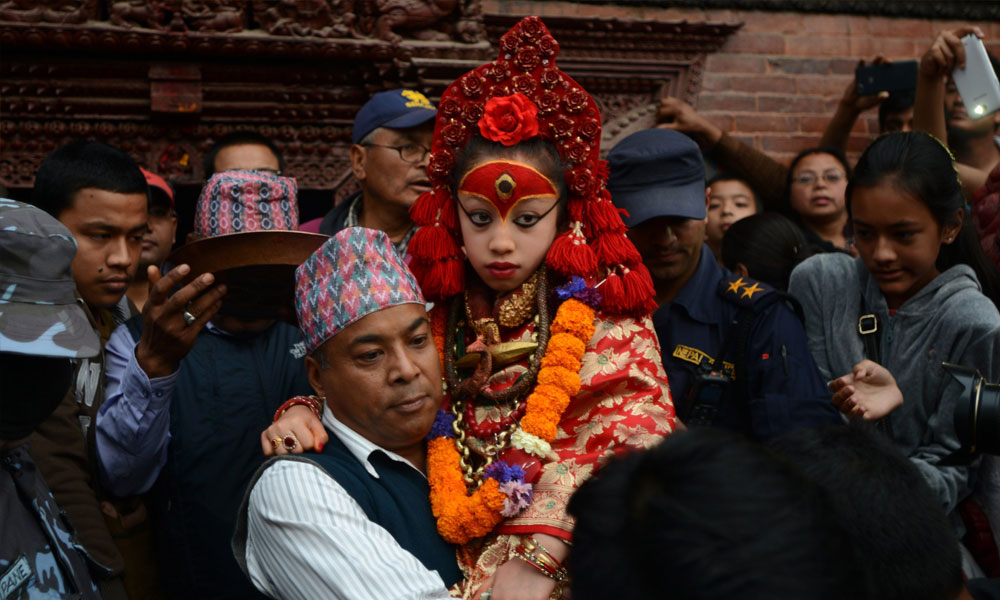
What is Kumari Puja, celebrated in Nepal?
Kumari Puja is a culturally rich festival celebrated amongst the Newari community in Nepal. During this event, Kumaris are worshipped as the Goddess Taleju. People believe that Goddess Taleju incarnates in the body of the Kumari girls.
Who is Kumari?
Kumari is generally known as the incarnate of Goddess Taleju. She is a young, pre-pubescent girl chosen from the Buddhist Newar community in Kathmandu Valley. She goes through numerous selection processes before being selected as the Kumari. Physical appearance and astrological attributes are some of the criteria.
When does Kumari Puja take place?
Usually, Kumari Puja is celebrated during the Indra Jatra Festival, which falls in September. The festival lasts a week, and Kumari Puja is one of its significant events.
Where does Kumari Puja take place?
Kumari Puja takes place at Kathmandu Durbar Square, the ancient historical landmark of Kathmandu. Kumari resides in the Kumari Ghar, just next to the historical palace.
What is the significance of Kumari Puja?
Kumari Puja has many significance and importance. She is believed to bring good luck, protection, and prosperity to the city and its inhabitants. Also, people believe she has a supernatural ability to heal people with diseases.
Can visitors meet the Kumari during Kumari Puja?
Yes, visitors are allowed to catch glimpses of Kumari during Kumari Puja. During the celebration of Indra Jatra, she appears on a balcony of the Kumari Ghar. You must know the dos and don’ts of the event, as photography and any forms of snapshots are restricted.
How can I seek blessings from Kumari during Kumari Puja?
You can seek blessings from Kumari during Kumari Puja by making offerings and performing a small ritual in her presence. People are recommended to approach her with humility and reverence.
Is Kumari Puja open to foreigners and tourists?
Kumari Puja is open to foreigners and tourists who wish to witness this traditional ceremony. However, they should follow the rules and regulations set by the authorities.
Can one visit the Kumari Ghar at other times of the year?
The Kumari Ghar is not open to the public throughout the year. However, visitors can explore Kathmandu Durbar Square and its historical sites when Kumari is not in view.
When was Kumari Puja started?
Some people believe that the last Malla King, Jaya Prakash Malla, started Kumari Puja after he was found playing dice with Goddess Taleju by his Queen. But some say Trilokya Malla had sexual intentions with Goddess Taleju. Still, she disappeared and later agreed to stay as a living Goddess embodying a young girl of the Shakya community.
View this post on Instagram
You may also like:


